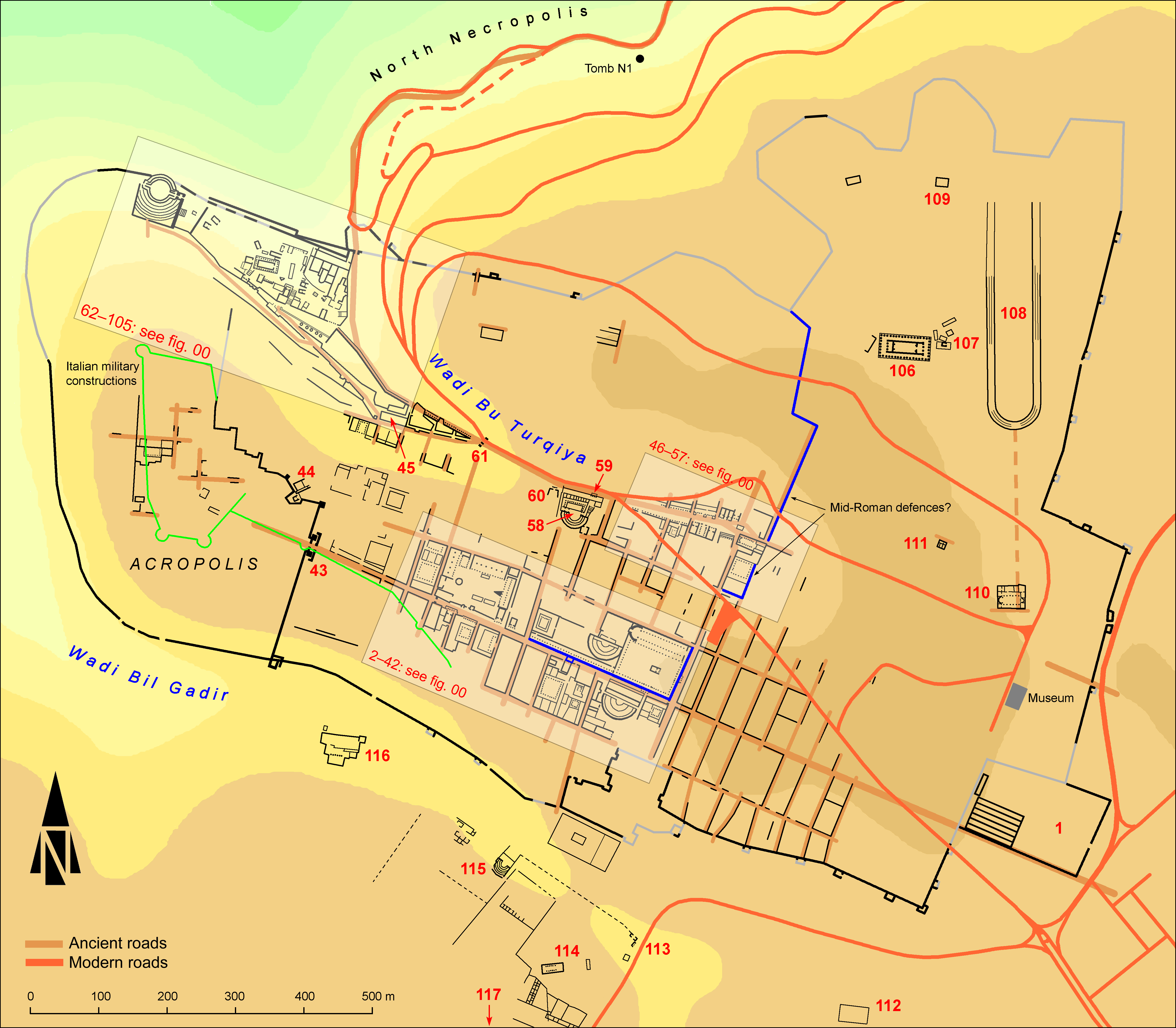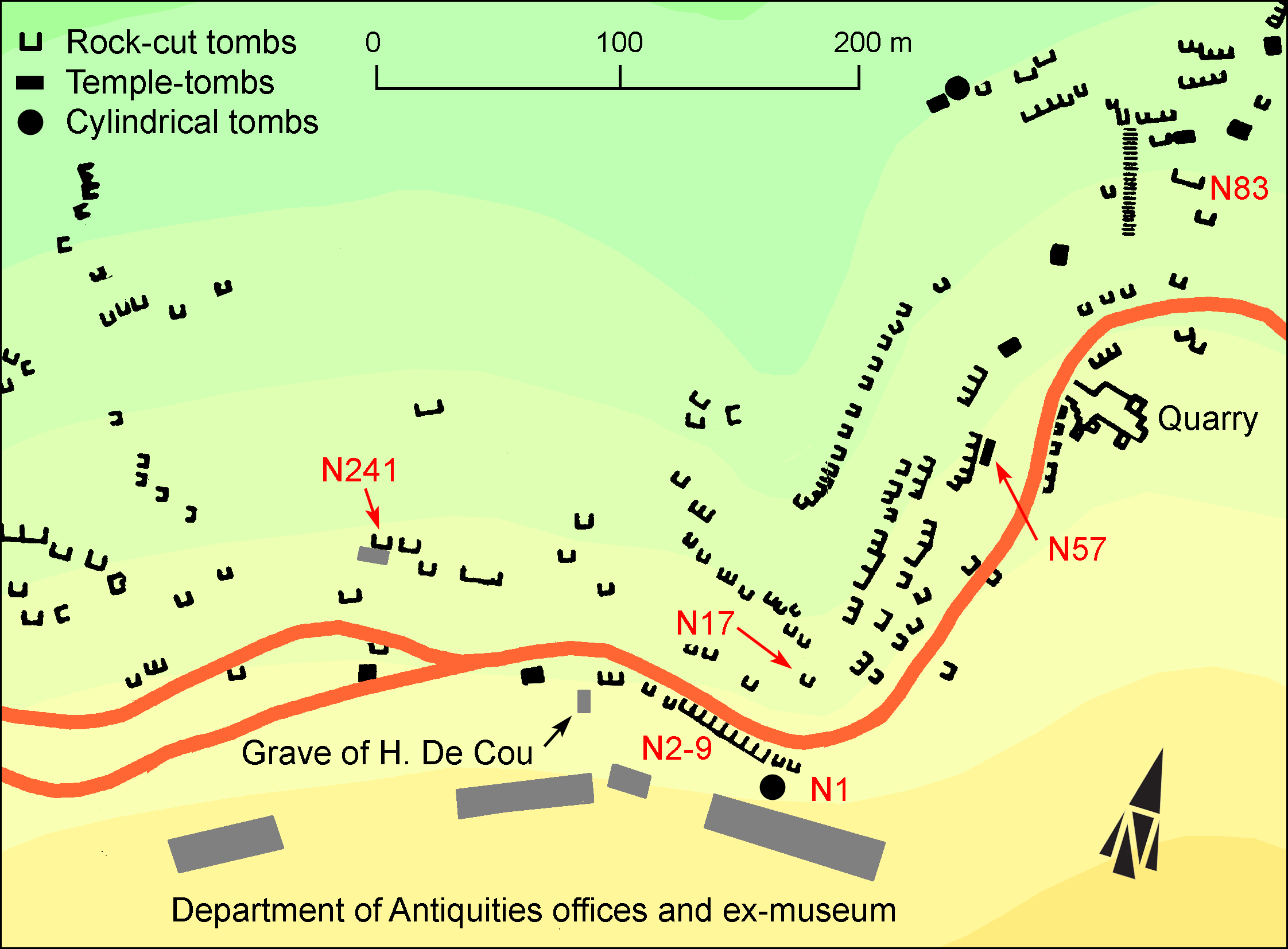EpiDoc XML:
GVCyr0082
Trismegistos ID:
738904
Source description
Support: Slightly tapered stele of white marble with strongly marked blue veins;
moulded above, with four small holes in the top for an attachment
(with the moulding w: 0.43 × h: 1.08 × d: 0.32).
Layout: Inscribed on the front face, beginning under the moulding
(w: 0.36 to 0.40 × h: 1.005 × d: 0.265 to 0.285); the letters are more closely packed together at ll. 1-4 and 9-17 than at
ll. 5-8.
Letters: 0.014; deeply cut letters still reddish from earth, without serifs; a lightly incised palm branch at the end of l. 18; alpha
with straight bar, zeta with vertical central bar, theta with central horizontal bar, kappa with long oblique bars, pi with
equal vertical strokes, non-slanting sigma, calice-shaped and widely open upsilon, phi with large loop and very tall vertical
stroke.
Date: Second century AD (lettering).
Findspot: Found before 1935 by G. Oliverio at
Cyrene ➚:
together with GVCyr0092 in the same rock-cut tomb of the
North Necropolis.
Place of origin: Findspot.
Last recorded location: Cyrene Sculpture Museum, 242.
Seen by C. Dobias-Lalou at Shahat:
in 1979 in the old Sculpture Museum and again in 2010 in the forecourt of the new Museum, which is since the
years 1990 the only Cyrene Museum.
Text constituted from: Transcription from stone (CDL).
Bibliography
From †Oliverio's papers Pugliese Carratelli – Oliverio 1961, n. 17, fig. 31 and Gallavotti 1962, whence SEG, 20.747; GVCyr 008 ➚. Cf. Morelli 1963, Chamoux 1991 (= Chamoux 1995), whence SEG, 41.1698 and Dobias-Lalou, BE, 1992.583; Dobias-Lalou 2018, p. 202, whence SEG 68.1745.
Text
Interpretive
Εἰμὶ μὲν Ἡφαιστοῦτος θυ-
γάτηρ Ἀκρισίου δὲ πατρός
λέγομαι δὲ Παρησία. - Νήπι-
ον εἰς Ἀΐδαο πύλας κατε-
5λήλυθα, οὐδὲ τέταρτον
ἔτος πλῆρες εἴδον γλυ-
κερὸν φάος ἠελίοιο·
οὐ καλυβοῖς ἐπ'ἐμοῖς
ἱλαρὸν κρότον εὔρυθμον
10εἶδον· οὐ λιγὺς αὐλὸς ἐ-
μαῖς ἐν παστάσι θροῦν ἐδό-
νησεν· οὐκ Ὑμέναιος κω-
μάζων ἔκρεκεν Μουσῶν
μέλος ἡδύ· ἀλλά με τὴν ἀ-
15δαῆ παῖδα σειγῆς τόπος
ἔσχεν, γράμμασιν ἐν στή-
λῃ λαλέουσαν ἐμὸν γέ-
νος οὐκέτι φωνῇ
Metrical
Εἰμὶ μὲν Ἡφαιστοῦτος θυ-
γάτηρ Ἀκρισίου δὲ πατρός
λέγομαι δὲ Παρησία. -
Νήπι|ον εἰς Ἀΐδαο πύλας κατε|(5)λήλυθα, οὐδὲ τέταρτον
| ἔτος πλῆρες εἴδον γλυ|κερὸν φάος ἠελίοιο·
| οὐ καλυβοῖς ἐπ'ἐμοῖς | ἱλαρὸν κρότον εὔρυθμον | (10) εἶδον·
οὐ λιγὺς αὐλὸς ἐ|μαῖς ἐν παστάσι θροῦν ἐδό|νησεν·
5 οὐκ Ὑμέναιος κω|μάζων ἔκρεκεν Μουσῶν | μέλος ἡδύ·
ἀλλά με τὴν ἀ|(15)δαῆ παῖδα σειγῆς τόπος | ἔσχεν,
γράμμασιν ἐν στή|λῃ λαλέουσαν ἐμὸν γέ|νος οὐκέτι φωνῇ
Diplomatic
ΕΙΜΙΜΕΝΗΦΑΙΣΤΟΥΤΟΣΘΥ
ΓΑΤΗΡΑΚΡΙΣΙΟΥΔΕΠΑΤΡΟΣ
ΛΕΓΟΜΑΙΔΕΠΑΡΗΣΙΑ ΝΗΠΙ
ΟΝΕΙΣΑΙΔΑΟΠΥΛΑΣΚΑΤΕ
5ΛΗΛΥΘΑΟΥΔΕΤΕΤΑΡΤΟΝ
ΕΤΟΣΠΛΗΡΕΣΕΙΔΟΝΓΛΥ
ΚΕΡΟΝΦΑΟΣΗΕΛΙΟΙΟ
ΟΥΚΑΛΥΒΟΙΣΕΠΕΜΟΙΣ
ΙΛΑΡΟΝΚΡΟΤΟΝΕΥΡΥΘΜΟΝ
10ΕΙΔΟΝΟΥΛΙΓΥΣΑΥΛΟΣΕ
ΜΑΙΣΕΝΠΑΣΤΑΣΙΘΡΟΥΝΕΔΟ
ΝΗΣΕΝΟΥΚΥΜΕΝΑΙΟΣΚΩ
ΜΑΖΩΝΕΚΡΕΚΕΝΜΟΥΣΩΝ
ΜΕΛΟΣΗΔΥΑΛΛΑΜΕΤΗΝΑ
15ΔΑΗΠΑΙΔΑΣΕΙΓΗΣΤΟΠΟΣ
ΕΣΧΕΝΓΡΑΜΜΑΣΙΝΕΝΣΤΗ
ΛΗΛΑΛΕΟΥΣΑΝΕΜΟΝΓΕ
ΝΟΣΟΥΚΕΤΙΦΩΝΗ
French translation
Translation source: Chamoux 1991
Je suis la fille d'Héphaistous et d'Akrisios, mon père. J'ai nom Parèsia.
Tout enfant, je suis descendue aux portes de l'Hadès et je n'ai même pas vu pendant quatre
années pleines la douce lumière du soleil.
Je n'ai pas vu près de ma maison s'élever le gai tapage des chants bien rythmés.
Les sons aigus de la flûte n'ont pas fait résonner mes portiques.
Hyménée conduisant le cortège nuptial n'a pas fait retentir la douce mélodie des Muses.
Non! Le monde du silence s'est emparé de l'enfant ignorante que j'étais:
pour dire quelle est ma famille, je n'ai que les lettres gravées sur une stèle, puisque ma voix s'est tue.
English translation
I am the daughter of Hephaistous and Acrisios, my father. My name is Paresia.
As a small child I went down to the doors of Hades and I did not complete four
years while enjoying the mild sun light.
I did not see near my house the joyful noise of well-rhythmed songs.
Nor did the sharp tone of the flute buzz under my porches.
Nor did Hymenaios lead the bridal procession and play the pleasant melody of the Muses.
No! The world of silence seized me, the ignorant child,
who am telling my family through letters cut on a stele and no longer through my voice.
Italian translation
Sono la figlia di Hephaistous e di Akrisios mio padre, il mio nome è Paresia.
Ancora bambina sono discesa alle porte di Ade e nemmeno per quattro
anni interi ho visto la dolce luce del sole.
Nella mia casa non ho visto il lieto rumore ben ritmato dei canti,
né l'aulo sotto i miei portici il suo suono limpido ha fatto vibrare,
né l’imeneo in processione ha fatto risuonare la dolce melodia delle Muse.
Ma il regno del silenzio si è impadronito di me, ignara bambina,
che ora parlo della mia famiglia con le lettere incise di una stele, non più con la mia voce.



